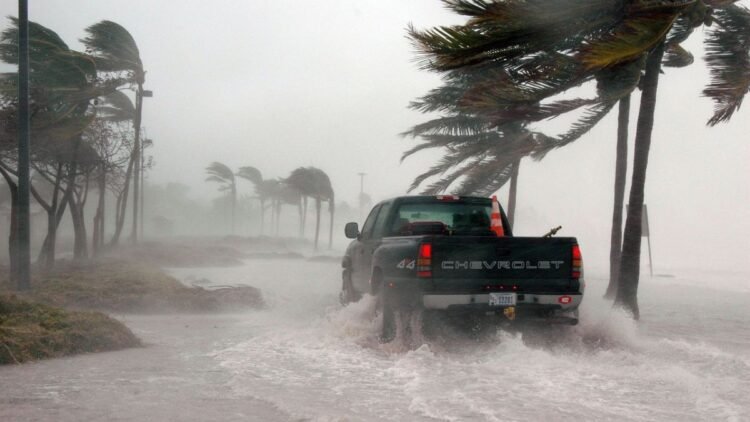On Sunday, August 20, 2023, Southern California experienced a rare and unusual natural phenomenon that was dubbed as a “hurriquake” on social media. A hurriquake is a combination of a hurricane and an earthquake that occur simultaneously or in close succession. In this case, a powerful tropical storm named Hilary hit the region with heavy rain and strong winds, while a magnitude 5.1 earthquake shook the area near Ojai, about 80 miles northwest of Los Angeles. The hurriquake caused widespread flooding, mudslides, power outages, and minor damage, but no major injuries or fatalities were reported.
What is a Hurriquake?
A hurriquake is not a scientific term, but a colloquial expression that describes the occurrence of a hurricane and an earthquake at the same time or within a short time span. A hurricane is a large rotating storm that forms over warm ocean waters and has sustained winds of at least 74 mph. An earthquake is a sudden shaking of the ground that results from the movement of tectonic plates along faults or fractures in the Earth’s crust. Both hurricanes and earthquakes are natural hazards that can cause significant damage and disruption to human lives and activities.
Hurriquakes: The Uncommon Intersection of Hurricanes and Earthquakes
A hurriquake is a very rare and unusual event, as hurricanes and earthquakes are governed by different physical processes and occur in different regions of the world. Hurricanes are more common in tropical and subtropical areas, while earthquakes are more common in seismically active areas along plate boundaries. However, there are some regions where both hurricanes and earthquakes can occur, such as the Caribbean, Central America, Japan, Taiwan, Philippines, etc. In these regions, there is a small but nonzero probability of a hurriquake happening.
How Did the California Hurriquake Happen?
The California hurriquake was the result of an extraordinary combination of meteorological and geological factors that coincided on Sunday, August 20, 2023. The meteorological factor was Tropical Storm Hilary, which originated from a disturbance south of the southern coast of Mexico associated with a tropical wave that entered the far eastern Pacific Ocean from Central America on August 12.
Hilary’s Formation and Intensification
The disturbance gradually intensified into a tropical depression on August 14, and then into a tropical storm on August 15. Hilary continued to strengthen as it moved westward over warm waters and favorable atmospheric conditions, reaching its peak intensity as a Category 4 hurricane with maximum sustained winds of 150 mph on August 18.
Hilary’s Interaction with Baja California
However, Hilary encountered cooler waters and stronger wind shear as it approached the Baja California Peninsula, which weakened it to a Category 2 hurricane before making landfall near Cabo San Lucas on August 193. Hilary then crossed the peninsula and entered the Gulf of California, where it regained some strength as a Category 1 hurricane before making another landfall near Guaymas on August 204. Hilary then weakened to a tropical storm as it moved northward over land and interacted with an upper-level trough that steered it toward Southern California.
Ojai Earthquake Strikes
The geological factor was an earthquake that occurred near Ojai, about 80 miles northwest of Los Angeles, at 2:41 p.m. local time on Sunday, August 206. The earthquake had a magnitude of 5.1 and a depth of 6.2 miles, according to the U.S. Geological Survey (USGS). The earthquake was caused by the movement of the San Cayetano Fault, which is part of the Transverse Ranges system that runs east-west across Southern California. The earthquake was felt across Ventura, Los Angeles, Santa Barbara, Orange, Riverside, San Bernardino, and San Diego counties. The earthquake triggered several aftershocks of magnitude 3.0 or greater in the following hours.
The Rare Convergence: #Hurriquake
The hurriquake occurred when Tropical Storm Hilary was approaching Southern California with heavy rain and strong winds at around the same time as the earthquake struck near Ojai. The coincidence of these two events created a rare and unusual situation that caught many people off guard and prompted them to share their experiences on social media using the hashtag #hurriquake.
What Were the Impacts of the California Hurriquake?
The California hurriquake had various impacts on different aspects such as:
The environment
The hurriquake brought potentially “catastrophic and life-threatening” flooding to Southern California and Nevada, according to the National Weather Service (NWS). The NWS issued flash flood warnings for parts of Los Angeles and Ventura counties into early Monday morning. The NWS also issued flood watches for parts of San Diego, Orange, Riverside, San Bernardino, Kern, Inyo, Clark , Lincoln , Nye , Esmeralda , and White Pine counties until Tuesday morning.
The NWS said that these regions should expect ” dangerous to catastrophic flooding ” due to the heavy rain from Hilary and the runoff from the mountains. The hurriquake also caused mudslides and debris flows in some areas, especially in the burn scars from recent wildfires . The hurriquake also brought strong winds that downed trees and power lines, causing power outages for tens of thousands of customers . The hurriquake also generated high surf and rip currents along the coast, posing a hazard for swimmers and surfers .
The infrastructure
The hurriquake damaged some roads, bridges, buildings, and other structures in some areas due to the flooding, mudslides, wind, and shaking. Some of the reported damages include:
A section of Highway 33 near Ojai was closed due to a rockslide triggered by the earthquake.
A bridge on Highway 95 near Needles was washed out by the floodwaters from the Colorado River.
A liquor store in Santa Paula suffered some damage to its shelves and products due to the earthquake.
A gas station in Oxnard had its canopy blown off by the wind.
A mobile home park in Thermal was flooded by the water from a nearby canal.
The people
The hurriquake affected the lives and activities of millions of people in Southern California and Nevada. Some of the effects include:
Several school districts in Southern California and Nevada announced school closures or delays for Monday, August 21, due to the impacts of the hurriquake.
Several flights at Los Angeles International Airport were delayed or canceled due to the weather conditions.
Several events and attractions were canceled or postponed due to the hurriquake, such as the Los Angeles Rams preseason game, the Hollywood Bowl concert, the Disneyland fireworks show, etc.
Several people were rescued or evacuated from their homes or vehicles due to the flooding or mudslides.
Several people experienced fear, anxiety, or stress due to the hurriquake, especially those who had previous trauma from natural disasters.
How Can You Prepare for a Hurriquake?
A hurriquake is a very rare and unpredictable event that can pose various risks and challenges for people living in areas where both hurricanes and earthquakes can occur. Therefore, it is important to be prepared for such an event by following some tips such as:
- Emergency Preparedness Essentials: Equip yourself with basic supplies like water, food, and medical essentials.
- Family Emergency Blueprint: Plan communication and meetup strategies with loved ones for hurriquake scenarios.
- Stay Updated: Regularly monitor local updates regarding weather and seismic activity.
- Safety First During a Hurriquake: Prioritize staying indoors and exercise caution on flooded routes.
- Flood Zone Precautions: Ensure readiness to evacuate if situated in areas susceptible to flooding.
- Mountainous Region Alert: Beware of potential landslides and mudslides due to rain or tremors.
- Coastal Area Advisory: Keep a vigilant eye on storm surges and tidal waves, and maintain distance from potentially vulnerable coastal structures.
- Power Outage and Fallen Objects: Ensure backup power and steer clear of electrified debris.
- Earthquake Protocol During a Hurriquake: Prioritize personal safety and follow the “drop, cover, and hold on” strategy.
Conclusion
The California hurriquake was a rare and unusual natural phenomenon that occurred on Sunday, August 20, 2023 , when Tropical Storm Hilary hit Southern California with heavy rain and strong winds , while a magnitude 5.1 earthquake shook the area near Ojai . The hurriquake caused widespread flooding , mudslides , power outages , and minor damage , but no major injuries or fatalities were reported.
The hurriquake was a challenging situation , but it was also an opportunity to show solidarity and compassion to those in need. The hurriquake was also a learning experience for people to be prepared for such rare and unpredictable events by following some tips and guidelines. The hurriquake was a reminder of the power and beauty of nature, as well as the resilience and courage of humanity.
(India CSR)























